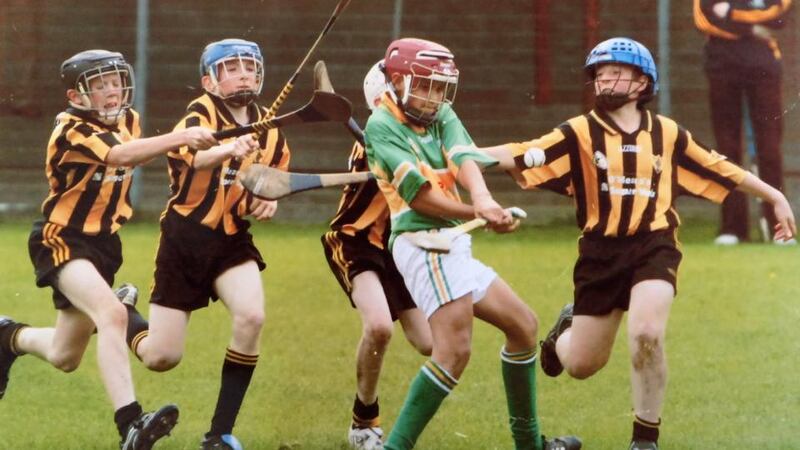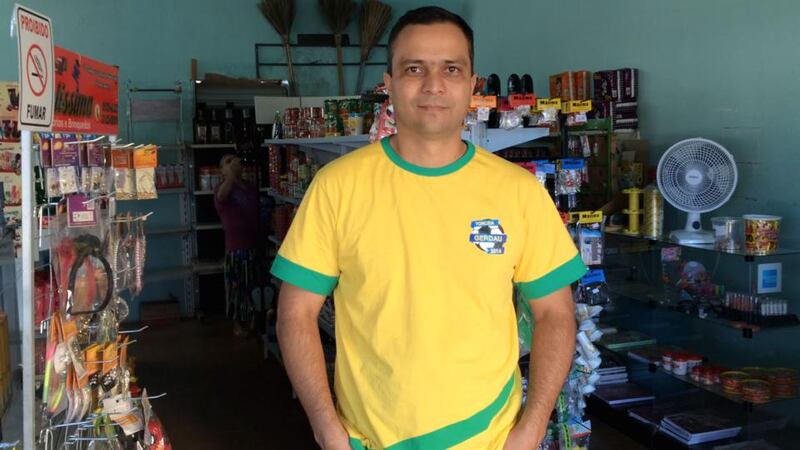Leonardo Gomes’s maroon helmet, two hurleys and a sliotar are resting by the post of a soccer goal at one end of a field of parched grass. Through the netting and the trees you can see the red chimney and low roof of an adjacent factory set against a sky so blue it’s as if a painted dome had been placed over the hemisphere.
As a place for Leonardo to exhibit his skills as perhaps Brazil’s only hurler this pitch has the merit of convenience, but especially of symbolism: the factory and the hurl, the seed and the fruit.
It is hard to know where this story begins, and impossible to guess where it will end. We can say for sure that what happens between those points involves an unlikely marriage of the town of Gort, Co Galway and this Brazilian city of Anapolis, 334,000 people strong and 140km west of the capital Brasilia in Goiás state.


What was once a straightforward if unusual tale of a poor Brazilian community meeting Ireland’s boom-time employment needs has transformed, as all migration stories do, into something much richer and more complex: one of repatriation and sadness, separation and longing, kindness and decency, gratitude and joy.
In the house where he lives with his warm, cheerful father, Cleomar, in the suburb of Nossa Senhora D’Abadia (Our Lady of the Abbey), Leonardo takes out the bundle of photographs and newspaper cuttings that are the most direct way to summon the memories of nine years spent growing up in Ireland.
Now a tall, muscular and handsome 17-year-old, Leonardo was a small 10-year-old when two-time All Star and former Galway goalkeeper John Commins described him as "as good as any underage hurler of his age in the county". Leonardo was a centre-half-back, a captain and fledgling leader.
Big trophy
In one brilliant photo taken during the under-12 county B final between Gort and Killimor, four players fruitlessly try to tackle the Brazilian-born boy as he fires downfield. On the sideboard is a scroll commemorating his taking part in the RTÉ hurling programme for kids C'mon Camán. In a frame beside it Leonardo holds a big trophy with Cleomar's arm wrapped around him. There is a booklet with testimonials by migrant children playing Gaelic Games. Leonardo writes: "My favourite thing about Ireland is the people because they are nice to me."
Leonardo’s talent was unusual but his family’s journey was not. Cleomar was among those many Brazilians from Anapolis who travelled to Ireland in search of work and a better life in the years around the turn of the millennium.
The link was a happy outcome of the closure of the huge meat factory – the one beside the soccer pitch – in sleepy Vila Fabril, a suburb on the outskirts of the city. One of the factory managers at the time was an Irishman named Jerry O’Callaghan, who had worked in Brazil’s meat business since the 1970s.
O’Callaghan knew the industry in Ireland was seeking skilled workers, and he acted as a go-between: first helping to send workers to the Kepak plant in Clonee, Co Meath, and then, in 1999, a further consignment to Seán Duffy Meat Exports in Gort. A trickle soon became a flood.
By 2007, some 1,600 people, or 40 per cent of Gort’s population, was estimated to be Brazilian. The town became a flag-carrier for Ireland’s boom-time migration, attracting TV crews and journalists eager to tell the tale of Brazilian exoticism infiltrating small-town Ireland.
Cleomar first travelled over for six months and worked in Gort’s meat factory – “I couldn’t even use the knife,” he remarks – before returning to fetch the rest of the family. Leonardo was three years old.
Corner shop
A skilled craftsman, Cleomar got a new job making pottery in Michael Kennedy Ceramics in the town. This is typical of the Anapolis story, which began with the meat factory connection but soon expanded to all sectors of employment, and all parts of Ireland too.
You get the feeling that many who travelled from the city would now struggle to pinpoint exactly how it all started.
In his corner shop in the Nossa Senhora D'Abadia neighbourhood, Josiel Vieira Santos, wearing a Brazil jersey for World Cup match day, mentions three years working as a bricklayer in Caherciveen, Co Kerry and Dublin. From the shelf he picks up a little brown bottle of Caracu Cerveja Escura – dark beer. "A bit like Guinness," he says.
At the city’s big Ceasa wholesale fruit and vegetable market, Claudinei Felicio offers a handshake so firm you can almost read in it his five years spent working as a stonemason near Raheen, Co Limerick. Right now Claudinei is weighing up his options. “My wife wants to go back,” he says happily in an Irish accent.
By far the greatest concentration of Irish stories is around the dusty streets of Vila Fabril, a district that arose in the 1950s to house workers from the factory. You only have to sit in the quiet Panificadora Fabril bakery for 10 minutes for people to start wandering in and shaking your hand. It's an opportunity to reminisce, even in silence. Behind the counter Marcia Reis speaks fondly of her seven years spent living in Ennis, where she also worked in a bakery – "Just like here," she shrugs.
Her colleague’s brown-skinned child makes cute faces around the other side; a boom-time baby, born in Ireland.
All speak enthusiastically of their time away, but many like Marcia – it is only months since she came back – have found the readjustment on their return to Anapolis tough. Leonardo’s first year back was, he says, tortuous – the problem being, as he says himself, “I am Irish”.
Rugby jersey
For others even the word Ireland conjures up feelings of sorrow and loss that are an inescapable part of the emigration experience. Around the corner on the main street a local man running a bar wears an Ireland rugby jersey, but he did not buy it himself. His son sent it over to him and, he adds sadly, the boy is now living in Australia.
If it’s more upbeat emigrant stories you’re after, Lucimeire Trindade is the woman to talk to. A slim, vigorous woman whose gift of the gab and verbal tics are as much evidence of her travels as the stamp on her passport, Lucimeire tells comic stories of those early days in Gort when newcomers were “survivors”, when there was a daily contest to be first to Super Valu to buy up the rice, and the language barrier was such an issue that one Brazilian newcomer took to eating cat food, thinking it was for humans. “And he thought it was nice!” she gasps.
There were only nine Brazilians in Gort when she arrived, Lucimeire says, and she not only watched the community grow, but contributed to its expansion.
“What we say is that everyone who went brought another person. My friend who went first, she brought myself, her two sisters and her cousin. I brought my brothers and then my uncles. One brought another, and another and another… It was very good, like, because you were away, but at the same time you were at home.”
Early every morning outside the AIB in the centre of the town, Brazilian workers would wait around for employers to come looking for help. Lucimeire has a story about that, told in a way that is scarcely believable in this little white-fronted house in Vila Fabril. “The postman stopped there one day to deliver letters to the AIB. And people were there waiting for someone to collect them to go to work. And this man came, it was only two days he was in Ireland, and people told him, ‘Look it, when a car stops you just go in, because they want someone to work’.
“The postman stopped there and went to the AIB . . . when he comes back, the Brazilian man was sitting in the car. The postman said, “yeah, okay?” The man said, “okay, okay, I go, yeah!” He wouldn’t go out of the car because people told him to just get into the car and a man will drive you and show you what to do. The postman said, “Come here and help get this man out of here!’”
In the chair across the room Cleomar laughs and lifts up his trouser leg to reveal a big ugly scar.
“In his first game of soccer in Ireland he broke it,” Leonardo points out.
Good people
What for an Irish person might be a serious inconvenience was for the new immigrant a life-changing event – Cleomar couldn’t work and lost his job. But he cannot say enough about the many good people he met in Gort: their kindness and their good spirits, and the jokes they shared.
There are about 400 Brazilians still in the Co Galway town, with the rest scattered to the winds. Among their number is Anderson Gomes, Leonardo's older brother, whose big friendly smile could not see him mistaken for a member of any other family.
Anderson is only back in Ireland a few months, working as a painter and in a garage, after four years back home in Anapolis – in the end he missed it too much. And now Cleomar, his mother Sandra and Leonardo miss him too much.
Lucimeire Trindade has the same trouble – a son who spent eight years growing up in Ireland and now wants to be no place else. “He says that’s his home. He doesn’t feel Brazil is his home,” she says.
“I told my son, ‘I think you should go, because you’re young, you’re not married, and you can go and start work and do something for yourself.’ You can do something here in Brazil, but it’s much harder.”
In this family and many others, you foresee the pendulum swinging between Ireland and Brazil for many years to come.
Anapolis has been booming since those days when hundreds of the city’s Brazilians packed their bags for Ireland. The meat factory has reopened, under new owners.
Cleomar has his own business setting up equipment for private events but, in an ironic twist, it is a daily struggle to find casual labour to do the work. He thinks he might return to Ireland some day, if the timing is right.
Next summer, when he finishes school, Leonardo will pay his first visit since he came back almost four years ago. You will know him if you see him: a Brazilian-looking boy with a hurley.











